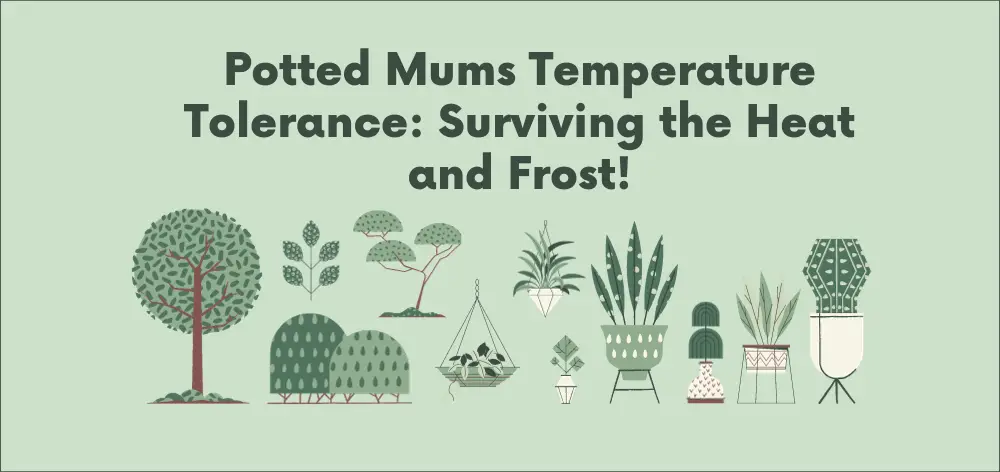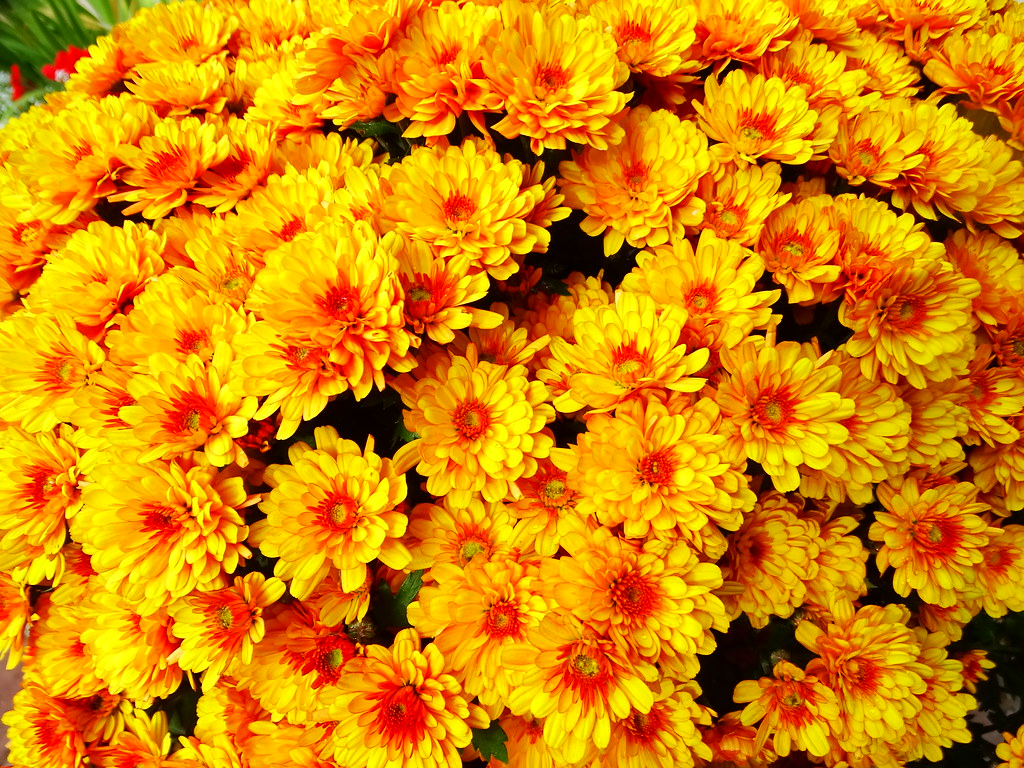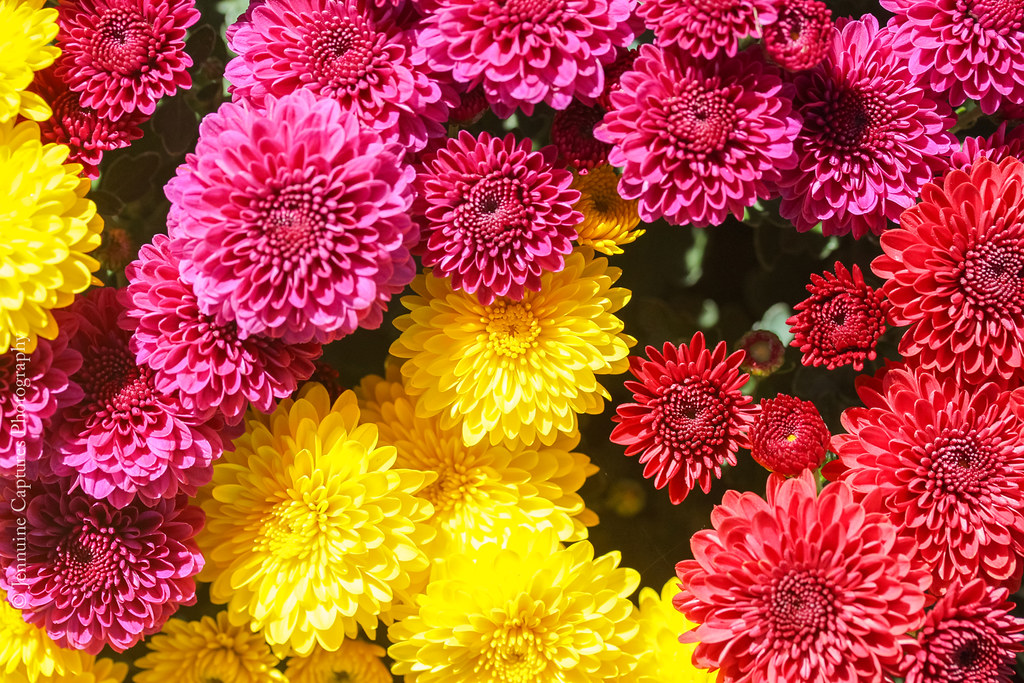They generally withstand temperatures as low as 20°F to 30°F (-6°C to -1°C). While mums can survive near-freezing temperatures, prolonged exposure, especially at or below 32°F (0°C), may cause damage.
At this point, ice crystals can form within the plant cells, potentially leading to cellular damage. To enhance freeze tolerance, it’s advisable to provide protective measures, such as applying a layer of mulch around the base and covering the plants during extremely cold spells.
These precautions help insulate the roots and foliage, reducing the risk of frost damage. Regular monitoring of weather conditions and taking appropriate steps to shield the mums can contribute to their overall winter hardiness and successful survival in colder climates.
Understanding the Potted Mums Temperature Tolerance
Understanding the temperature tolerance of potted mums is essential for their survival. While they can withstand light frosts and cold, it is important to bring them indoors during hard freezes to prevent damage to their roots.
Potted Mums And Their Natural Temperature Tolerance:
Potted mums, also known as chrysanthemums, are popular flowering plants that can add a splash of vibrant color to any garden or home. These plants have a natural temperature tolerance that allows them to thrive in a variety of climates.
Here are some key points to know about their temperature tolerance:
- Potted mums are known for their ability to withstand cooler temperatures, making them a great choice for fall and early winter displays.
- These plants can typically handle temperatures as low as 20-30 degrees Fahrenheit (-1 to 2 degrees Celsius) without suffering any damage.
- Mums are well-suited for cool autumn nights and can tolerate light frosts, enhancing their appeal for seasonal decorations.
- However, it’s important to note that potted mums are not able to survive harsh freezing conditions, especially when exposed for long periods. Freezing temperatures can damage the delicate roots of these plants and can often result in permanent loss.
Factors Affecting The Temperature Tolerance Of Potted Mums:
Several factors can influence the temperature tolerance of potted mums. Understanding these factors can help you provide the optimal conditions for your mums to thrive. Here are some key points to consider:
- Growing Zone: Potted mums have different hardiness ratings based on their growing zones. It’s crucial to choose mums that are suitable for your specific climate zone to ensure their ability to withstand temperature fluctuations.
- Maturity of the Plant: Young mums, especially those recently purchased or just transplanted, may have a lower tolerance for cold temperatures than fully established plants. It’s important to gradually acclimate them to cooler conditions.
- Plant Variety: Different varieties of potted mums may have varying levels of temperature tolerance. Some have been bred specifically to withstand colder temperatures, while others are more sensitive to cold.
- Proper Care: Providing adequate care, such as regular watering, proper fertilization, and appropriate mulching, can enhance the temperature tolerance of potted mums. Healthy plants are generally more resilient to temperature extremes.
Remember, understanding the natural temperature tolerance of potted mums and the factors that affect it is essential for ensuring the success of these beautiful plants in your garden or home. With the right care and attention, you can enjoy the vibrant colors and beauty of potted mums throughout the seasons.
Potted Mums Are Mums Freeze Tolerant?
Potted mums are generally hardy plants that can tolerate mild frosts and colder temperatures. However, their ability to withstand freezing temperatures partly depends on the variety of mum and their specific cultivar. Some mums are bred to have greater frost tolerance, while others may be more susceptible to cold damage.
To ensure the freeze tolerance of your potted mums, it is essential to choose the right variety for your specific climate. Look for mum cultivars that are specifically labeled as freeze-tolerant or cold-hardy. These varieties have been bred to withstand freezing temperatures and are more likely to survive and thrive in colder climates.
In addition to selecting the appropriate mum variety, proper care during freezing temperatures is crucial. When the temperatures drop, it is important to provide your potted mums with some protection. Consider bringing the pots indoors if possible, or move them to a sheltered area such as a porch or a garage. You can also cover them with a frost cloth or a layer of mulch to provide additional insulation.
Winterizing Potted Mums: Potted Mums Temperature Tolerance Winter
Potted mums can tolerate light frosts and cold temperatures with ease, but a hard freeze can permanently damage the roots. It’s important to move them indoors when extremely low temperatures or a freeze is expected to keep them alive over winter.
As winter approaches, it is important to take proper steps to ensure the survival of your potted mums. Proper winterization is essential to protect the plants from extreme temperatures and harsh weather conditions. By following a few simple steps, you can help your potted mums thrive and bloom again in the coming seasons.
Steps To Prepare Potted Mums For Winter:
- Inspect and Prune: Before winter sets in, carefully inspect your potted mums for any signs of disease or pests. Remove any dead or diseased leaves or flowers, and prune the plants to encourage healthy growth in the following seasons.
- Reduce Watering: As the weather cools down, gradually reduce the amount of water you give to your potted mums. Overwatering during winter can lead to root rot and other issues. Allow the soil to dry out between waterings, but make sure the plant doesn’t completely dry out.
- Apply Mulch: To provide insulation and protect the roots from freezing temperatures, apply a layer of mulch around the base of the potted mums. Use organic materials such as straw, leaves, or wood chips to create a protective barrier.
- Move Indoors: If you live in a region with extremely low temperatures or freezing conditions, it is best to move your potted mums indoors or to a sheltered area. Find a cool place with indirect sunlight, such as a garage or basement, to protect the plants from harsh winter weather.
Proper Storage For Potted Mums During Winter:
- Choose the Right Container: When moving your potted mums indoors, make sure to select a container that is large enough to accommodate the root system. Use well-draining soil and ensure the pot has drainage holes to prevent waterlogging.
- Provide Adequate Lighting: While your potted mums are in storage, they still require some amount of light. Place them near a window where they can receive indirect sunlight for a few hours each day. Alternatively, you can use grow lights to supplement the light requirements.
- Monitor Temperature and Humidity: Ideally, potted mums should be stored in an area with a temperature range of 45-55°F (7-13°C) and a humidity level around 50-60%. Avoid placing them near heating vents or in areas with extreme temperature fluctuations.
- Water Sparingly: During winter storage, potted mums will require less frequent watering. Check the soil moisture regularly and water only when the top inch of soil feels dry. Overwatering can lead to root rot, so it’s important to maintain proper soil moisture levels.
How To Revive Potted Mums After Winter:
- Gradual Acclimatization: As winter comes to an end and the temperatures start to rise, it’s time to prepare your potted mums for their return outdoors. Gradually acclimate them to the outdoor conditions by moving them to a sheltered area for a few hours each day, gradually increasing their exposure to sunlight and temperature fluctuations.
- Re-Potting: If the plants have outgrown their containers or the soil has become compacted, it’s a good idea to repot them. Choose a slightly larger container with fresh potting soil and ensure proper drainage.
- Fertilize and Water: Once your potted mums are back outside, give them a boost of nutrients by applying a balanced slow-release fertilizer. Water regularly and maintain consistent soil moisture levels to promote healthy growth and flowering.
By following these simple steps, you can successfully winterize your potted mums and help them survive through the winter months. With proper care and attention, your mums will reward you with beautiful blooms year after year
How Potted Mums Handle Heat
Potted mums can handle heat fairly well, but extreme temperatures can be detrimental to their roots. It’s important to bring them indoors during a hard freeze to ensure their survival.
The Ideal Temperature Range For Potted Mums:
- Potted mums prefer temperatures between 60-70°F (15-21°C) during the day and slightly cooler temperatures at night.
- They thrive in cool and crisp fall weather, which enhances their vibrant colors and prolongs their blooms.
Understanding Heat Stress In Potted Mums:
- Potted mums are susceptible to heat stress, especially in regions with hot summers.
- Heat stress can cause wilting, leaf curling, and even premature flowering.
- It is important to provide proper care and protection to prevent heat stress in potted mums.
Tips To Protect Potted Mums From Excessive Heat:
- Watering: Keep the soil consistently moist, but not oversaturated. Water the mums deeply in the morning to ensure proper hydration before the heat of the day.
- Mulching: Apply a layer of organic mulch around the base of the plants to insulate the soil and retain moisture. This helps regulate the soil temperature and reduces evaporation.
- Shade Cloth: If temperatures exceed 90°F (32°C), consider using a shade cloth to provide partial shade for your potted mums. This can help protect them from direct sunlight and reduce heat stress.
- Location: Place your potted mums in a spot that receives morning sun and afternoon shade. Avoid placing them in areas with intense afternoon sun exposure.
- Watering Schedule: Adjust the watering schedule during hot weather, increasing the frequency if needed. Monitor the moisture level in the soil and avoid letting it dry out completely.
- Pruning: Remove any dead or damaged foliage to improve air circulation and promote healthy growth. This also helps reduce the overall stress on the plant.
- Fertilization: Avoid excessive fertilization during periods of high heat, as it can further stress the plants. Stick to a balanced fertilizer and follow the recommended application rates.
By following these tips, you can ensure that your potted mums stay healthy and thrive even during hot weather conditions. Remember to monitor the temperature closely and take necessary steps to protect your plants from excessive heat.
Protecting Potted Mums From Frost And Cold
Protecting potted mums from frost and cold is essential to their survival. While mums can withstand light frosts and cool temperatures, it is crucial to move them indoors during extreme cold or hard freezes to prevent permanent damage to the roots.
The Impact Of Frost And Cold On Potted Mums:
- Potted mums are generally hardy plants, but they do have a limit to how much cold they can tolerate.
- Frost and cold temperatures can damage potted mums, particularly if they are exposed to them for a prolonged period.
- Extreme cold can kill the roots of the potted mums and cause permanent damage to the plant.
Signs Of Frost Damage In Potted Mums:
- If potted mums have been exposed to frost or cold temperatures, there are common signs to look out for to determine if damage has occurred.
- The leaves of the potted mums may turn brown or black, indicating frost damage.
- The stems may become soft or mushy, and the flowers may wilt or die.
- Frost-damaged potted mums may also show signs of leaf discoloration or browning.
Preparing Potted Mums For Frost And Cold:
- To protect potted mums from frost and cold temperatures, there are several steps you can take:
- Before the onset of freezing temperatures, bring the potted mums indoors or place them in a protected area, such as a covered porch or garage.
- If bringing the potted mums indoors is not possible, you can cover them with a frost blanket or burlap to provide some protection from the cold.
- Make sure to water the potted mums thoroughly before covering them to help insulate the roots.
- Avoid overwatering the potted mums during cold weather, as damp soil can make them more susceptible to frost damage.
- Remove any dead or wilted flowers or foliage from the potted mums to prevent the spread of diseases.
Remember, protecting potted mums from frost and cold is crucial for their survival. By following these precautions, you can enjoy healthy and vibrant mums year after year.
Can the Temperature Tolerance of Potted Mums Affect Their Survival?
The temperature tolerance of potted mums is one of the most common tree mortality reasons. Extreme heat or cold can stress the plants, and if not properly cared for, they may not survive. It’s essential to monitor and regulate the temperature to ensure the mums’ survival.
Frequently Asked Questions For Potted Mums Temperature Tolerance
Can Potted Mums Survive Frost?
Potted mums can survive light frosts and cold, but a hard freeze can kill the roots permanently.
What Temperature Is Bad For Mums?
Mums can withstand light frosts and cold temperatures, but a hard freeze can kill roots in pots permanently.
Do You Need To Cover Mums For Frost?
Covering mums for frost is essential to protect them from low temperatures and freezes. Light frosts can typically be endured, but a hard freeze can permanently damage the roots in potted mums. It is recommended to move mums indoors when extremely low temperatures or a freeze is forecasted.
Additionally, covering the plants at night during freeze warnings can help keep them attractive and healthy. Removing any dead blossoms as soon as they wilt is also beneficial.
What Is The Lowest Outdoor Temp For Mums?
Mums should be moved indoors when extremely low temperatures or a freeze is expected. A hard freeze can kill roots in pots permanently.
Conclusion
Potted mums are a beautiful addition to any garden or patio, but it’s important to understand their temperature tolerance to ensure their survival. While these plants can handle light frosts and cold temperatures fairly easily, a hard freeze can be detrimental to the roots in pots, potentially causing permanent damage.
Therefore, it is crucial to move your potted mums indoors when extremely low temperatures or a freeze is in the forecast. Additionally, covering the plants at night when freeze warnings are in effect can help protect them from frost and keep them looking attractive and healthy.
By following these simple steps, you can ensure the longevity of your potted mums and enjoy their vibrant blooms for seasons to come. So keep an eye on the weather forecast, and take the necessary precautions to protect your potted mums from extreme temperature fluctuations.
Related Topic:
Insect Invasion: Threat to Utah’s Fir Forests
 Dr Ahsanur Rahman, PHD
Dr Ahsanur Rahman, PHD
UK Forests Collapse Imminent: Act Now Against Climate!
 Dr Ahsanur Rahman, PHD
Dr Ahsanur Rahman, PHD
Lightning Strikes Threat: Boreal Fires Jeopardize Carbon
 Dr Ahsanur Rahman, PHD
Dr Ahsanur Rahman, PHD









